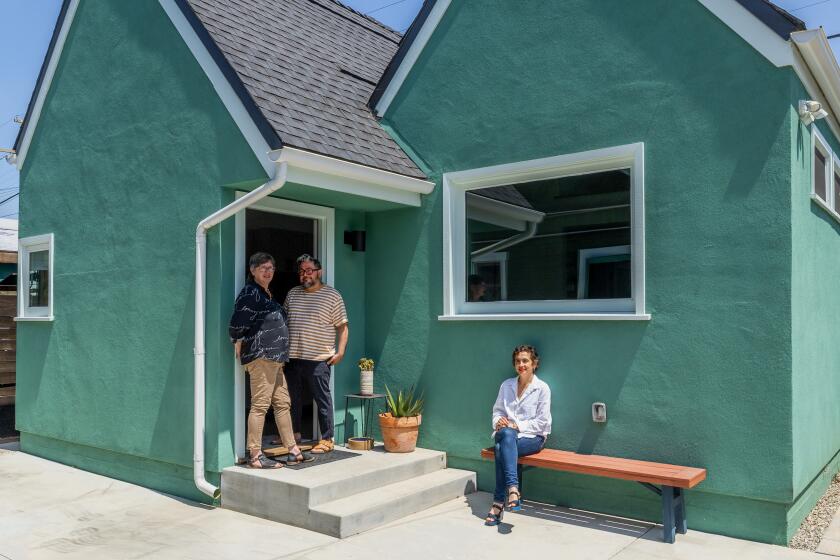STRUCTURES ‘NEW JERUSALEM’ : Traces of History : Memories of the crossroads community serve as a reminder of Ventura County’s heritage.
In a region as change-prone as Southern California, landmarks aren’t always visible to the naked eye. Some of the more significant structures now exist as ghostly presences, their memories waiting to be exhumed by the historically curious.
In Ventura County, one such place is “New Jerusalem,” a.k.a. El Rio. Based in an undeveloped area once known as the San Pedro Precincts, the humble crossroads community was settled in 1875 by Simon Cohn, a Jewish immigrant from Germany who arrived with $300 in his pocket.
Two years after the birth of Ventura itself, Cohn opened up a general store. Two Cohn brothers and another Jewish proprietor eventually started separate businesses on opposing corners. The intersection known as the “four corners” turned into a commercial gathering place for resident ranchers and farmers. Eventually the town was to encompass roughly a square mile, most of it ranches and small farms.
In the late 1800s, the town’s prospects were looking very bright, as this early report bears witness: “The surrounding country is exceedingly inviting and very productive. The town is well located and will doubtless grow into importance once reached by railway.”
The railway, like manifest destiny, came swiftly. Early in the 1900s, the Oxnard brothers came, opening their huge American Beet Sugar Works and founding Oxnard. Simon Cohn resisted the Oxnards’ offer to build the Beet Works on his land. He also refused to sell and transport his buildings, the way many did, to serve as housing for the sudden boom town. Cohn lived in the hometown of his devising until his death in 1936.
Finally, in the ‘50s, U.S. 101 came, paving over the center of the town that Cohn built. To find the former heart of New Jerusalem, proceed to the looming, gleaming Union Bank building in Oxnard. Trampled underfoot there, where the Financial Plaza meets U.S. 101 at Vineyard Avenue, is a pivotal chapter in local history.
Anna Seward, a schoolteacher who came west to Ventura in 1883, wrote letters home to Ohio about her travels. Those letters now offer valuable, although highly subjective, historical insight. She gave this odd account of New Jerusalem: “Its earliest settlers were two Hebrew children who opened a saloon for the irrigation of the passing public. Hence the name. We saw no wings and heard no harps; but the street was paved with gold, the bright yellow of the barley straw spread to keep down the dust.”
The truth be told, the “irrigation of the public” was not a civic priority. In fact, not long after Simon Cohn brought his new wife Minnie home to New Jerusalem from San Francisco, the saloon closed its doors. Later, Cohn--a model citizen as well as a wealthy landowner--built a Catholic Church in El Rio, as well as a sports arena that played host to boxing and wrestling bouts.
The matter of New Jerusalem’s name is subject to some speculation. According to the noted late Ventura journalist E. M. Sheridan, the area was initially settled in 1868 as “Jerusalem” by a small group of Campbellites--a religious sect. As visions of building a colony withered, they soon moved on. Sheridan reported that judge J. D. Hines called the place “New Jerusalem” in reference to the Jewish ownership, but the name was never recognized officially. The town became known officially as El Rio, or the river, for the semi-dry Santa Clara River.
Now the stuff of historical lore, New Jerusalem is testament to the bygone frontier ethic and the time when a lone man could stake a claim and settle a town.
The modern El Rio still boasts remnants of a simpler, rural Ventura life. From the humble tracts that make up El Rio, post-modernist encroachments of the new Oxnard Town Center are visible. But within this enclosed network of blocks, many houses sit amid small avocado orchards--a small reminder of the agricultural heritage of early Ventura.
Successive layers of pavement and progress can’t erase certain memories.
More to Read
Sign up for Essential California
The most important California stories and recommendations in your inbox every morning.
You may occasionally receive promotional content from the Los Angeles Times.






